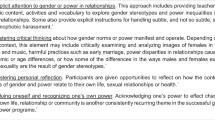Abstract
The overall extent of evidence-based culturally responsive health education programs targeting ethnic minority groups in Hawai‘i is limited. The few that do exist were adapted from models developed with other majority ethnic groups in mind and may not always be appropriate for Native Hawaiian or Pacific Islander youth (Okamoto et al. in J Alcohol Drug Educ 54(1):56–75, 2010; Helm and Baker in J Ethn Cult Divers Soc Work 20(2):131–149, 2011; Po’a-Kekuawela et al. in J Ethn Cult Divers Soc Work 18(3):242–258, 2009). The need for a culturally responsive, evidence-based health curriculum is clear considering the large disparities reported among Hawaiian youth in health, academic achievement, and other identified risk factors. School-based health interventions are an opportunity not only to improve the physical well being of students, but also to increase their ability to learn and succeed in school. The University of Hawai‘i at Manoa-Center on Disability Studies (UH-CDS) received a highly competitive grant from the US Office of Adolescent Health to develop a teen pregnancy and sexually transmitted infection (STI) prevention curriculum for Hawai‘i middle school youth. The authors will detail a collaborative process that led to a culturally responsive sexual health curriculum for middle school youth designed to meet the rigorous standards of an evidenced-based review and more importantly reduce teen pregnancies and STI transmission.
Similar content being viewed by others
References
Okamoto, S. K., Po’a-Kekuawela, K., Chin, C. I. H., & Nebre, L. H. (2010). Exploring culturally specific drug resistance strategies of Hawaiian youth in rural communities. Journal of Alcohol and Drug Education, 54(1), 56–75.
Helm, S., & Baker, C. K. (2011). The need to consider ethnocultural context in prevention Programming: A case example from Hawaii. Journal of Ethnic and Cultural Diversity in Social Work, 20(2), 131–149.
Po’a-Kekuawela, K., Okamoto, S. K., Nebre, L. H., Helm, S., & Chin, C. I. H. (2009). ‘A’ole drugs! Cultural practices and drug resistance of rural Hawaiian youth. Journal of Ethnic and Cultural Diversity in Social Work, 18(3), 242–258.
Sy, A., Greaney, M., Nigg, C., Hirose-Wong, S. M. (2011). Developing a measure to evaluate a positive youth development program for Native Hawaiians: The Hui Mālama o ke Kai rubrics of Hawaiian values. Asia-Pacific Journal of Public Health, 1–12. doi:10.1177/1010539511427760.
Hawaii state profile fiscal year. (2010). Sexuality Information and Education Council of the United States. Retrieved from http://www.siecus.org/index.cfm?fuseaction=Page.ViewPage&PageID=1294.
Kost, K., & Henshaw, S. (2013). U.S. teenage pregnancies, births and abortions, 2008: State trends by age, race and ethnicity. Guttmacher Institute. Retrieved from http://www.guttmacher.org/pubs/USTPtrendsState08.pdf.
Center for Disease Control and Prevention. (2012). Youth risk behavior surveillance-United States, 2011. Morbidity and Mortality Weekly Report 61(4). Retrieved from http://www.cdc.gov/mmwr/pdf/ss/ss6104.pdf.
U.S. Census Bureau. (2013). Asians fastest-growing race or ethnic group in 2012, census bureau reports. U.S. Department of Commerce. Retrieved from http://www.census.gov/newsroom/releases/archives/population/cb13-112.html.
Ishibashi, K. (2004). Hawaii population update. Honolulu: Kamehameha Schools, PASE report. Retrieved from http://www.ksbe.edu/spi/PDFS/Reports/Demography_Well-being/03_04_12.pdf.
Medically Accurate Sexuality Health Education Act. (2009). Hawaii Code Ann. § 321-11.1.
Hawaii State Board of Education (2013). Abstinence-based education policy. Retrieved from http://www.hawaiiboe.net/policies/2100series/Pages/2110.aspx.
Kirby, D. (2007). Emerging answers 2007: Research findings on programs to reduce teen pregnancy and sexually transmitted diseases. Washington, DC: National Campaign to Pevent Teen and Unplanned Pregnancy. Retrieved from http://www.thenationalcampaign.org/EA2007/EA2007_sum.pdf.
Alford, S. (2003). Science and success: Sex education and other programs that work to prevent teen pregnancy, HIV and sexually transmitted infections. Washington, DC: Advocates for Youth.
Brindis, C.D., Sattley, D., Mamo, L. (2005). From theory to action: Frameworks for implementing community-wide adolescent pregnancy prevention strategies. San Francisco, CA: University of California, San Francisco, Bixby Center for Reproductive Health Research and Policy, Department of Obstetrics, Gynecology and Reproductive Sciences, and the Institute for Health Policy Studies. Retrieved from http://crhrp.ucsf.edu/.
Lerner, R. M., & Benson, P. L. (2003). Developmental assets and asset-building communities: Implications for research, policy, and practice. New York, NY: Kluwer Academic/Plenum Publishers.
Benson, P. L., & Leffert, N. (2001). Developmental assets in childhood and adolescence. In N. J. Smelser & P. B. Baltes (Eds.), International encyclopedia of the social and behavioral sciences. New York: Elsevier Science.
Simpson, K., & Freeman, R. (2004). Critical health promotion and education: A new research challenge. Health Education Research, 19, 340–348. doi:10.1093/her/cyg049.
Klingner, J.K, Artiles, A.J., Kozleski, E., Harry, B., Zion, S., Tate, W. Duran, G.Z. & Riley, D. (2005). Addressing the disproportionate representation of culturally and linguistically diverse students in special education through culturally responsive educational systems. Education Policy Analysis Archives, 13(38) Retrieved from http://epaa.asu.edu/epaa/v13n38/.
Ladson-Billings, G. (1995). But that’s just good teaching! The case for culturally relevant pedagogy. Theory into practice, 34(3), 159–165. Quotations from (pp. 162–163).
Zehr, M. (2010). Hawaiian cultural influences in education: School engagement among Hawaiian students. Education Week, 29(28), 5.
Hollins, E. R. (1996). Culture in school learning. New Jersey: Lawrence Erlbaum Associates Inc.
Kana‘iaupuni, S. M. (2004). Identity and di-versity in contemporary Hawaiian families: Ho‘i hou i ka iwi kuamo‘o. Hülili: Multi- disciplinary research on Hawaiian well-being, 1(1), 53–71.
McGregor, D., Minerbi, L., & Matsuoka, J. (1998). A holistic assessment method of health and well-being for Native Hawaiian communities. Pacific Health Dialogue, 5(2), 361–369.
McCubbin, H., Thompson, E., Thompson, A., & Fromer, J. (1998). Resiliency in ethnic minority families: Native and immigrant families. Thousand Oaks, CA: Sage.
Office of Adolescent Health. (2010). HHS awards evidence-based teen pregnancy prevention grants. U.S. Department of Health & Human Services. Retrieved from http://www.hhs.gov/news/press/2010pres/09/20100930a.html.
Author information
Authors and Affiliations
Corresponding author
Rights and permissions
About this article
Cite this article
Manaseri, H., Uehara, D. & Roberts, K. Making Pono Choices: A Collaborative Approach to Developing a Culturally Responsive Teen Pregnancy and Sexually Transmitted Infections Prevention Curriculum in Hawai‘i. Matern Child Health J 18, 2332–2340 (2014). https://doi.org/10.1007/s10995-013-1395-6
Published:
Issue Date:
DOI: https://doi.org/10.1007/s10995-013-1395-6




